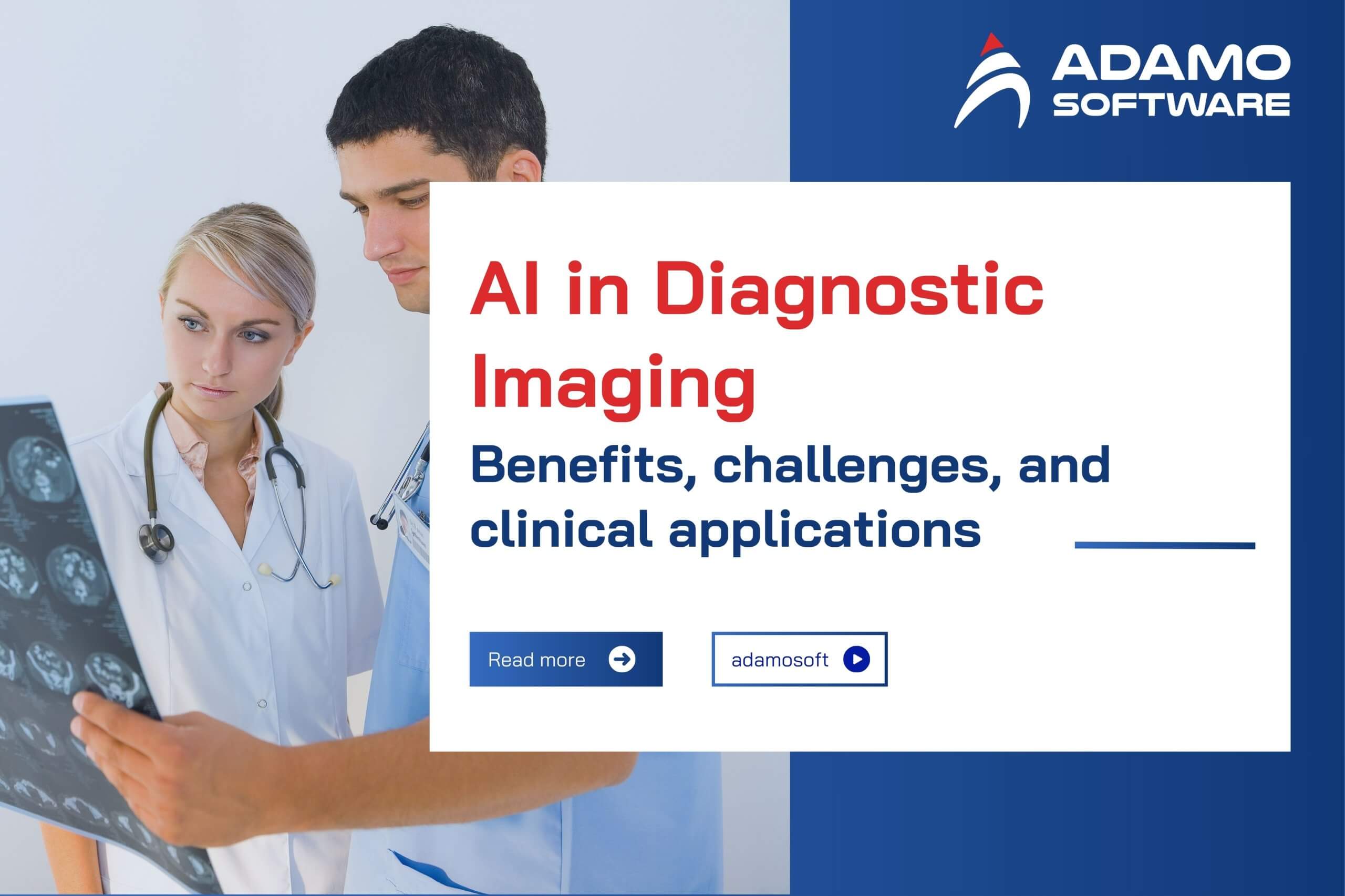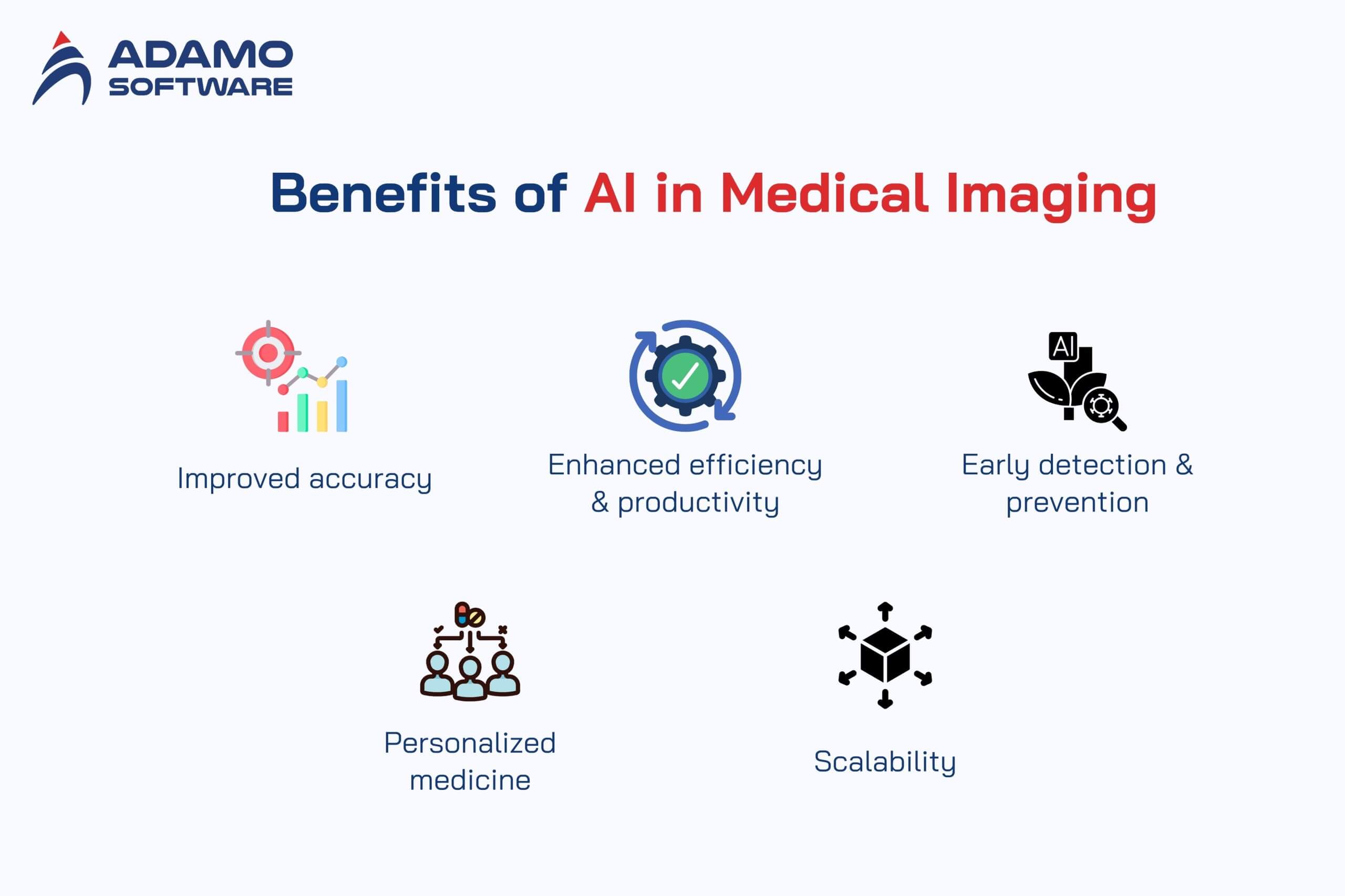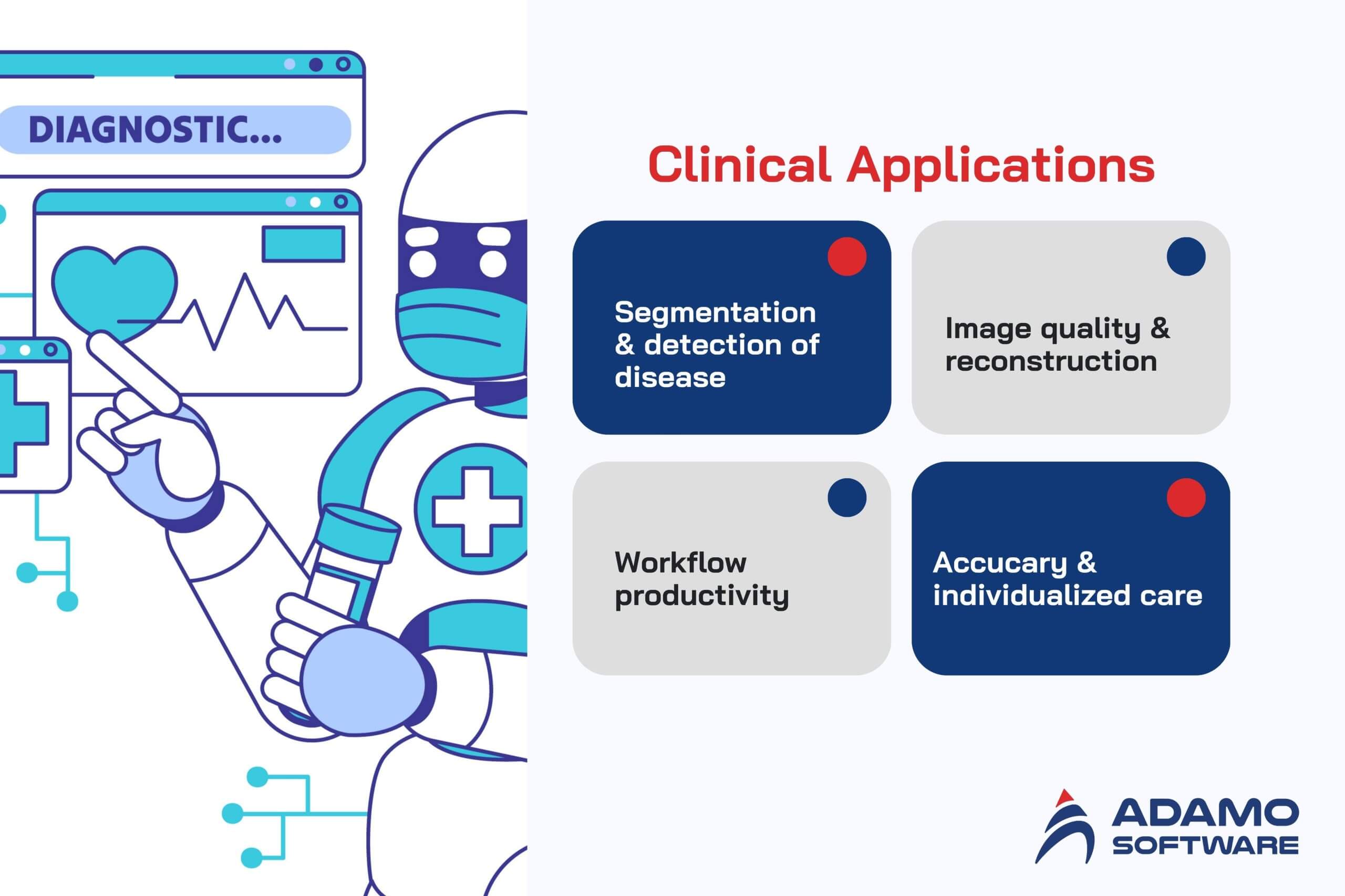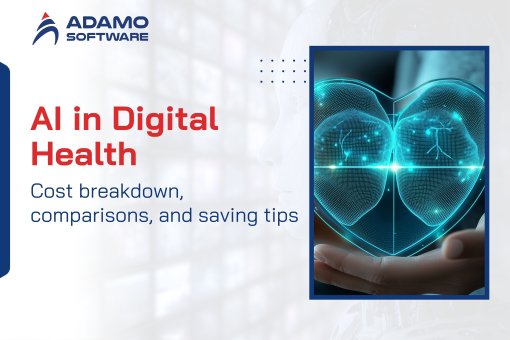AI in Diagnostic Imaging: Benefits, challenges, and clinical applications

AI in diagnostic imaging is reshaping healthcare. Learn how Adamo Software delivers secure, smart, and human-centered medical solutions.
AI in diagnostic imaging is altering how doctors see and interpret medical imagery. Previously, radiologists and doctors had to spend a lot of time studying images in search of disease detection indicators. However, Siri can now do it more quickly, more accurately, and without leaving anyone tired. AI in diagnostic imaging will not replace physicians but will make them more productive. It can help to notice things that can be overlooked by the human eye. It can compare their cases within a matter of seconds.
The significance of this technology is that medical imaging is at the center of most diagnoses. X-rays, CT scans, MRIs, and ultrasounds are the most used tools in diagnostics today. They discover cancers, heart disease, brain disorders, and much more. Manual work can take a lot of time and cause errors. ICT can decrease the number of mistakes, save time, and improve the patients’ results. It raises the issue of trust, privacy, and the importance of human judgment in medicine, at the same time.
In this article, we will discuss why AI is needed in diagnostic imaging, what advantages it has, what difficulties lie on its way, and how it has been used in the real world. Last, we will give some speculations about its future in healthcare.
I. Importance of AI in diagnostic imaging
The role of AI in diagnostic imaging is crucial, as AI enables physicians to identify issues easily and in a short period. It accompanies them with details hard to notice at first sight and with numerous images. This improves diagnoses and makes treatment faster.
In a 2024 review, it was shown that AI techniques- and in particular convolutional neural networks- have revolutionized the interpretation of X-rays, CTs, and MRIs. The systems also learn patterns that may not be seen by humans, making it more accurate and efficient to read the images.
A 2024 study revealed that the AI and radiologists’ reading time reduced by approximately 25%. Sensitivity rose by 12% without any increase in specificity. What this implies is that the doctors recorded a higher number of genuine cases without causing spurious alarm.
These results explain why AI in diagnostic imaging is crucial. It accelerates the work and makes results sharper but does not affect safety. It is also useful in hectic hospitals where accuracy and time are of the essence.
In one such study published in 2024, a generative AI system in 11 hospitals increased the efficiency of radiograph reporting by an average of 15.5% and up to 40% among individual radiologists, with high accuracy.
A wide-ranging 2024 overview on the topic of AI in medical imaging also noted its various applications: image segmentation, disease detection, image cleanup, treatment planning, prognosis of future disease progression, quality assurance, and monitoring of changes with time. These activities enhance doctors’ performance and patient outcomes.
Re-saying the words once more: AI in diagnostic imaging is a significant instrument nowadays. It adds advantages of speed, accuracy, and value to the reading of medical images. And it enables physicians to concentrate on what is most important–treating patients.
II. What are the potential benefits of AI in medical imaging?
AI in medical imaging offers a diverse set of advantages to healthcare. It improves diagnosis with greater accuracy and speed, and it contributes to finding the disease at an earlier stage. AI in diagnostic imaging assists physicians with a better understanding. Such systems can cope with large volumes of data and routine tasks. This allows doctors to spend more time with patients. Ultimately, AI in diagnostic imaging increases care for physicians and the patient.
The main benefits are as follows:

- Improved Accuracy – AI identifies fine details and minimizes errors on the part of anyone assessing at hand.
- Enhanced Efficiency and Productivity – AI helps to save time with repetitive tasks.
- Early Detection and Prevention -AI helps detect the disease soon, thus increasing survival rates.
- Personalized Medicine – AI can assist in treating each patient with the required medicines.
- Scalability – AI scanners allow faster screening of large populations.
1. Enhanced Accuracy
AI systems take seconds to analyze thousands of images and identify even minute features that a human might be unaware of. As an illustrative example, in 2024 one of the studies demonstrated that AI can improve breast cancer screening by decreasing false-negative results by over 20%, with no decrease in specificity, which indicates a smaller number of missed cases. This shows that AI in diagnostic imaging can serve as a fail-safe (backup) to radiologists and can enhance decision-making.
2. Improved Efficiency and Productivity
Millions of scans are being produced annually, and radiologists are under heavy workloads. Computer-aided diagnostic systems can relieve labor-intensive processes such as volume assessment of tumors or organ circumference. The same 2024 clinical trial that found AI assistance reduced reporting times by 25-40 per cent in radiology and did not reduce accuracy. This indicates that AI in diagnostic imaging assists doctors in working more quickly and seeing more patients safely.
3. Early Detection and Prevention
AI can point out indications of illness years before their symptoms are manifest. In lung cancer screenings, the AI technology has demonstrated the early classification of small nodules compared to human readers. This helps to treat and improve the outcomes sooner (ScienceDirect). The sooner the detection, the better chances of survival- this is what early intervention means. This makes diagnostic imaging through AI an effective instrument of prevention besides being a treatment tool.
4. Personalized Medicine
Its ability to combine scans with patient history, lab findings, and even genetics, does not characterize readers of images. A 2024 review documented how this integration enables personalized treatment where doctors can customize treatment according to the needs of patients. This makes AI in diagnostic imaging an even greater shift to precision medicine, care that is personal and not in a one-size-fits-all approach.
5. Scalability for Large-Scale Screening
Sometimes, hospitals and clinics do not manage to satisfy the demand for imaging services. With AI, it is possible to screen a large population at a given time. One potential European project in 2024 demonstrates how AI could be used to process nationwide screening programs for breast cancer. It evaluates the scans in bulk and still marks potential cases of abnormality to be reviewed by humans. This establishes that AI in diagnostic imaging is no longer a technology applied to individual patients but also to public health.
Also read:
AI in personalized medicine: Key Benefits and Use Cases
AI in telemedicine: Benefits, challenges and use cases
Ready to Outsource?
Get top-tier IT talent without the hassle. Contact us now!
III. Drawbacks of AI-powered diagnostic imaging
AI in diagnostic imaging is a huge help, however, challenges are real. These are bias, excessive dependence, confusion, and ethical hazards. They can influence fairness, trust, and safety. Diagnostic imaging AI should be treated with caution to prevent harm.
The major drawbacks are Main drawbacks include:
- Bias and Discrimination -AI can replicate unfair trends in data.
- Skill Erosion– Overspecialization can suppress skill endowment.
- Transparency and Accountability -AI decisions are opaque.
- Testability and Ethics – They may not have been tested and as such raise issues of safety and legality.
1. Bias and Discrimination
Diagnostic imaging AI can be taught using biased training data, and mirror that bias at the point of diagnosis. As an example, it is possible that narrow datasets can train a model that will underperform on underrepresented groups. A 2024 study on fairness concluded that AI systems can harbour demographic shortcuts and make biased predictions across groups. This demonstrates that bias could damage patients and restrict the utility of AI.
2. Skill Erosion (De-skilling)
The AI tools can cause physicians to get complacent and less proficient by relying too much on automation. The ability of clinicians to detect improvements when using AI decreases over time once they are used to not relying on it – a phenomenon also seen with GPS. That cautions us that AI in diagnostic imaging will undermine human expertise unless it is balanced with practice.
3. Transparency and Accountability
Physicians do not necessarily know how the AI concluded, and that is detrimental to trust. Deep learning models tend to lack explicit logic, missing a transparent way to determine liability or explain a diagnosis. This interferes with legal transparency and ethics. That is why AI in the context of diagnostic imaging is a sensitive instrument to operate with.
4. Validation and Ethics
AI tools are successful in isolated cases but not in a real-world context. There are randomized clinical trials in imaging AI and not all studies are properly reported. The claims guidelines adopted in 2024 are to enhance transparency and reproducibility. To this, there are privacy risks and vague liability which are a primary ethical concern. National and international regulations that define imaging AI as potentially high-risk in terms of harm faced by the population, are increasingly being adopted, e.g., the EU AI Act (2024).
IV. Real-world clinical applications of AI image analysis
The application of AI in diagnostic imaging helps to facilitate numerous real medical tasks. It aids in disease detection, provides better image quality, offers faster MRI, and provides precision care. These applications aid care in being speedier, clearer, and safer. A is emerging as a collaborator to physicians in diagnostic imaging.
Main applications are:

- Segmentation and Detection of Disease – AI marks organs and detects disease at an early stage.
- Image Quality and Reconstruction– AI improves resolution and lessens the radiation dose or contrast.
- Workflow Productivity– AI accelerates scans and re-orders work.
- Accuracy and Individualized Care – AI assists in making individualized treatment methods.
1. Segmentation and Disease Detection
Resources AI in diagnostic imaging provides doctors with automatic identification of regions such as tumors, organs, and lesions. A 2024 Review revealed deep learning tools to be able to segment medical images in various organs and detect diseases with a maximum of 100% accuracy in precise tests. These instruments enable clinicians to work more quickly and positively in the case of the detection of disease.
2. Image Quality and Reconstruction
AI enhances the appearance of images and their acquisition. AI in CT and MRI algorithms that decrease noise and artifacts, improve resolution, and lessen the amount of contrast agent to levels as low as 90% of gadolinium-based contrast agents thus leading to safer and easily distinguished images (European Radiology Experimental). It is the equivalent of clearer images with reduced risk to patients. AI in diagnostic imaging also helps with safe protocols and better results.
3. Workflow Productivity
AI in diagnostic imaging can smooth out the work process and speed it up. In MRI technologies, AI assists in quicker scans, automatically segments images, and automates report-centralized tedious activities, allowing radiologists to process and attend to more patients. This enhances the speed of care, saves on wait times. It also allows doctors to re-focus more on diagnosis than on repetitive tasks.
4. Precision and Personalized Care
Diagnostic imaging with AI can enable precision medicine. It aids in correlating imaging results with patient information to personalize care. In a 2024 multimodal review, it was noted that the integration of imaging and clinical data through AI enhances decision-making with approximately a 6.2 percentage point increase in the diagnostic performance. The idea with AI on diagnostic imaging is that it can be used to prescribe treatment more precisely according to individual patients.
V. Final thoughts

As an information technology company that leverages the advantages of AI in diagnostic imaging, at Adamo Software we believe that AI in diagnostic imaging is one of the most potent tools of the future of healthcare. It assists physicians in observing more precisely, in coming to decisions more quickly, and in treating patients more effectively. Our solutions are built specifically to integrate AI into the actual medical processes, so that technology can benefit, instead of harm, people at every point.
And the thing is that we also believe that it plays an important role as much as technology. That is why we develop healthcare software with a high level of attention paid to security, privacy, and usability. AI must produce correct results in diagnostic imaging and give doctors and patients assurance about every decision. Innovation and responsibility are important characteristics of our work.
Going forward, it seems that AI in diagnostic imaging is not a trend but rather the staple of modern medicine. At Adamo, we pride ourselves on making healthcare more human, more efficient, and minimizing risks with our solutions. When approached the right way, AI will not only transform diagnostics but also help redefine the standard of care for all.











